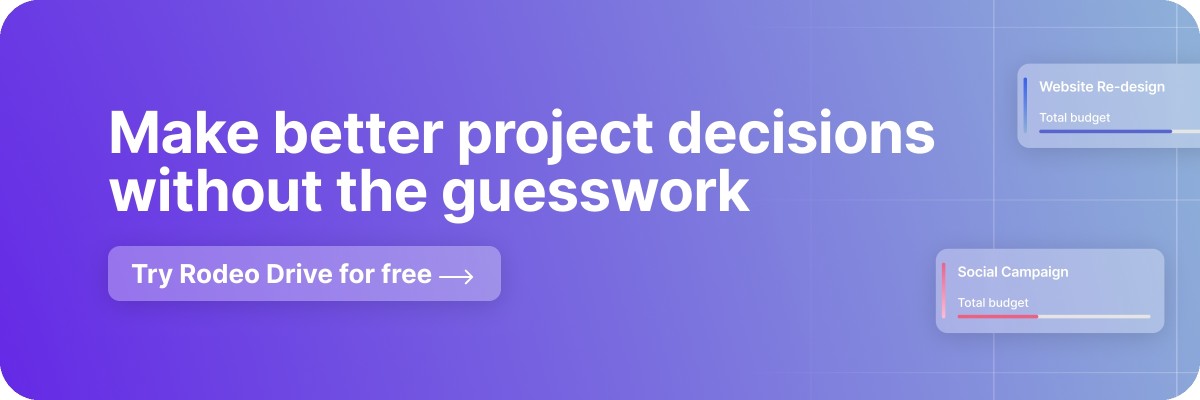Product Manager vs. Project Manager: Understanding the Differences
Many people use the terms ‘project manager’ and ‘product manager’ interchangeably. They sound the same, so they must mean the same thing, right? Actually, no.
Both positions are critical to a business’s success in their own ways. One focuses on developing a product strategy, while the other brings that vision to life.
In this blog, we’ll break down the differences between the two to help you understand which one is right for your team depending on your goals, as well as whether just one person can take on both positions.
If you’re a project manager looking for an all-in-one project management solution, check out Rodeo Drive here.
Understanding product vs. project
Before understanding the roles and responsibilities of each type of manager, it’s important to be able to distinguish between products and projects.
A product is a good or service that is created to meet user needs. Products can be intangible – such as software or consulting services – or they can be physical items. Regardless of the type of good, all products progress through a lifecycle in which they’re developed, introduced to the market, and updated according to changing user needs. When a product is no longer needed, it’s eventually retired.
On the other hand, a project is a collection of tasks that are necessary to achieve certain goals, outcomes, and deliverables within a designated period. All projects undergo the five phases of project management: initiating, planning, executing, monitoring, and closing.
The main difference between products and projects is their timelines. Projects are temporary, whereas products continue adapting to user needs in order to avoid retirement. Maintaining an existing product often requires several projects.
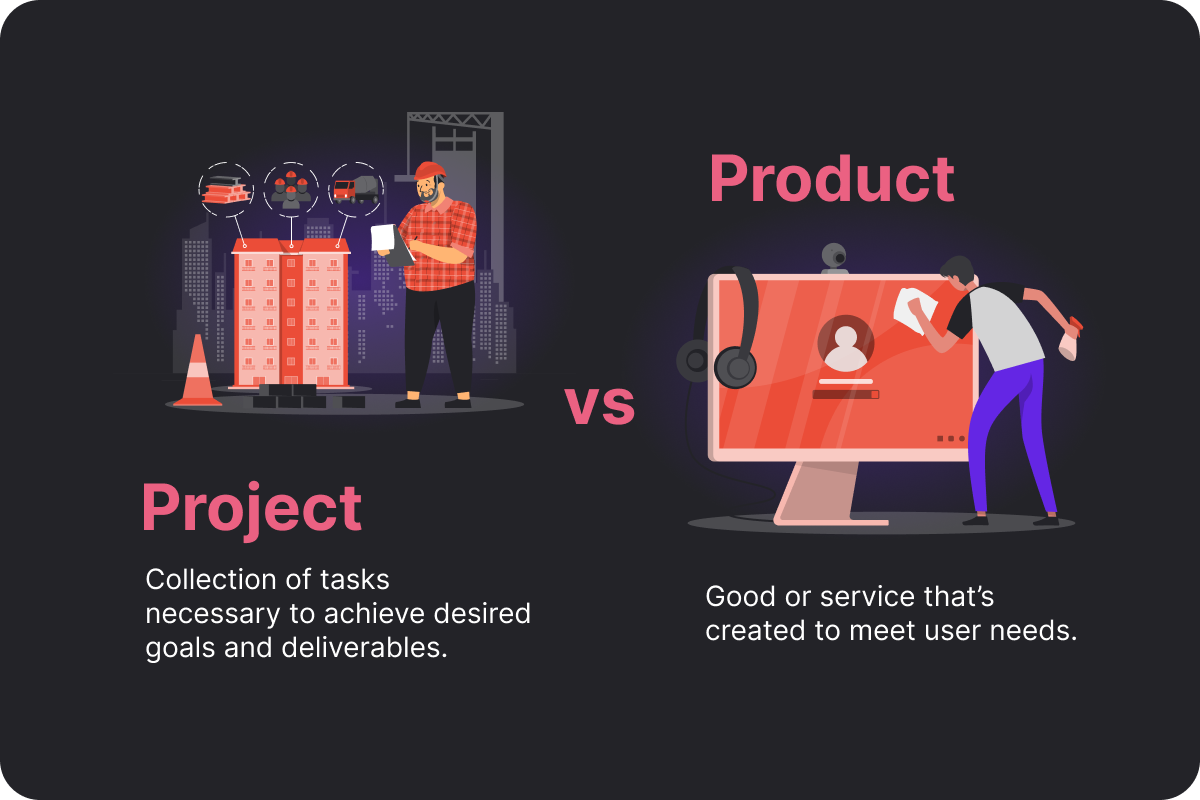
What is a product manager?
Product managers are essentially the CEO of the product – their focus is almost entirely on strategy.
Perhaps most importantly, product managers are in charge of determining the product direction and communicating it to the rest of the company. Their other responsibilities usually include leading the development team, researching new product opportunities, and crafting the product roadmap based on user needs.
Product managers are also held accountable for the product’s business performance, meaning they must collaborate with sales and marketing teams to ensure the product is profitable and correct the shortcomings of underperforming products or features.
Product managers must have strong product sense skills, which include knowing when it’s appropriate to launch a product versus when to continue testing or stall a launch due to a bug.

What is a project manager?
In contrast, the project manager role is more about execution. In essence, project managers turn product managers’ strategic plans into action by developing a timeline and managing tasks that result in the completion of the desired deliverables and goals.
The project manager sees projects through to completion and ensures they’re on time, within budget, and of high quality. Their job includes managing risks, resources, and scope as well.
Project managers often employ project management methodologies that help their teams work efficiently and avoid falling behind schedule. Some methodologies – such as scrum – also attempt to incorporate product managers into the project process.
Project management software tools are another excellent way to keep projects organized at every stage of the project lifecycle. Many tools like Rodeo Drive include task management, time tracking, invoicing, and reporting features that can help automate project managers’ administrative tasks.
Also read: Scrum Master vs. Project Manager: The Key Differences
8 key differences between product and project managers
If the differences between the two positions are still a bit murky, here are 8 key differences between the two types of managers to help clarify:
1. Product managers are external-facing and project managers are internal
Because product managers are focused on creating value for end users via the product, their role is primarily focused on understanding what direction the product should take. This makes their role very external – they need to be aware of business trends and market demands.
Meanwhile, end users may never see the results of a project manager’s work, because project management deliverables are often intended to improve the efficiency of internal processes rather than assisting with product development. This is coupled with the fact that much of a project manager’s job is to oversee the project team’s work.
While deliverables differ by project, in general, this makes the duties of product managers very external and project managers very internal.
Related: A Comprehensive Guide on How to Become a Project Manager
2. One focuses on product vision, the other on the project timeline
Product managers spend a significant amount of time developing their product vision, gathering the requirements, and prioritizing them accordingly. They must make sure their vision fits within the market, and that the sales and marketing teams are on board.
Project managers spearhead the project timeline. Building a project timeline involves creating a list of all tasks necessary to meet an objective, estimating how long each will take, and assigning them to the appropriate team member.
As such, both managers are responsible for communicating updates on their respective visions and timeline to stakeholders.
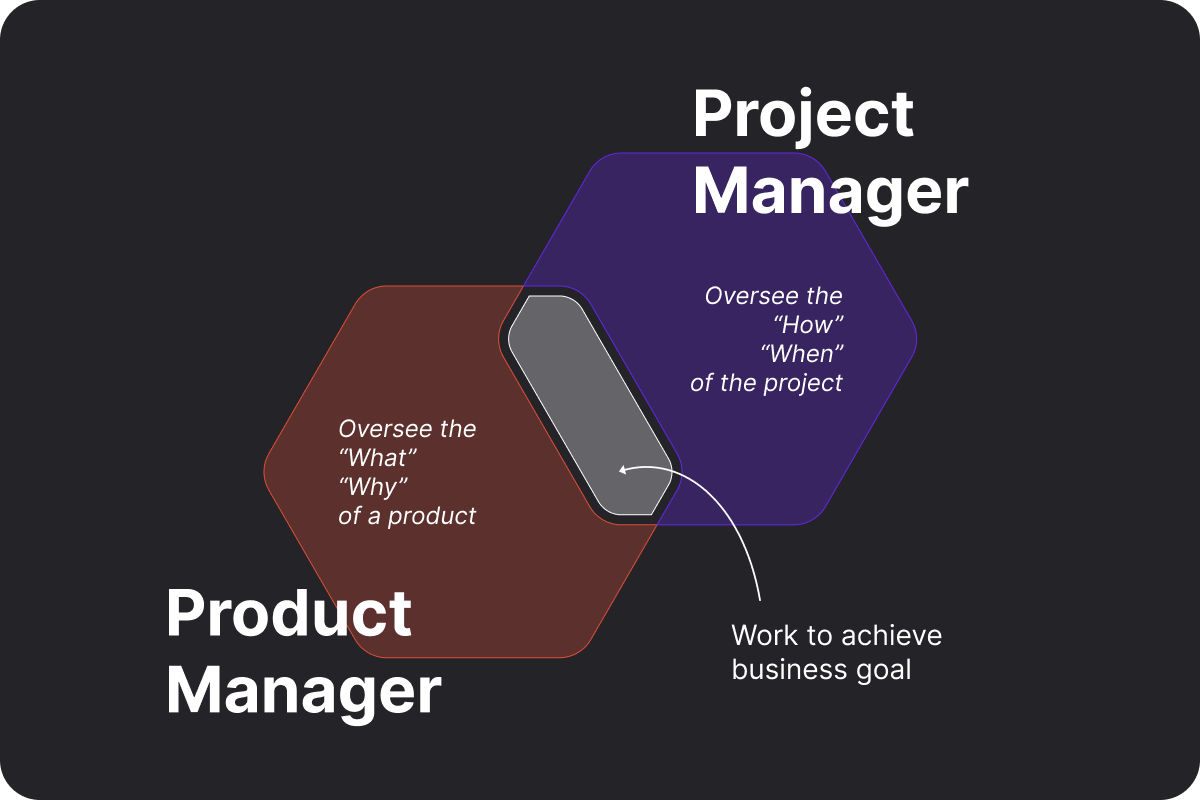
3. Emphasis on strategy vs. execution
As previously discussed, both manager roles are connected, they each just focus on different pieces of the puzzle.
Project managers spend the vast majority of their time on work coordination, or in other words, executing the project plan. The strategy determined by the product manager heavily influences what those project plans will look like.
Related: The Project Management Checklist: 12 Steps to Follow
4. Each role requires different skillsets
Different responsibilities require different skill sets. Here’s a look at the expertise you’ll need for each role:
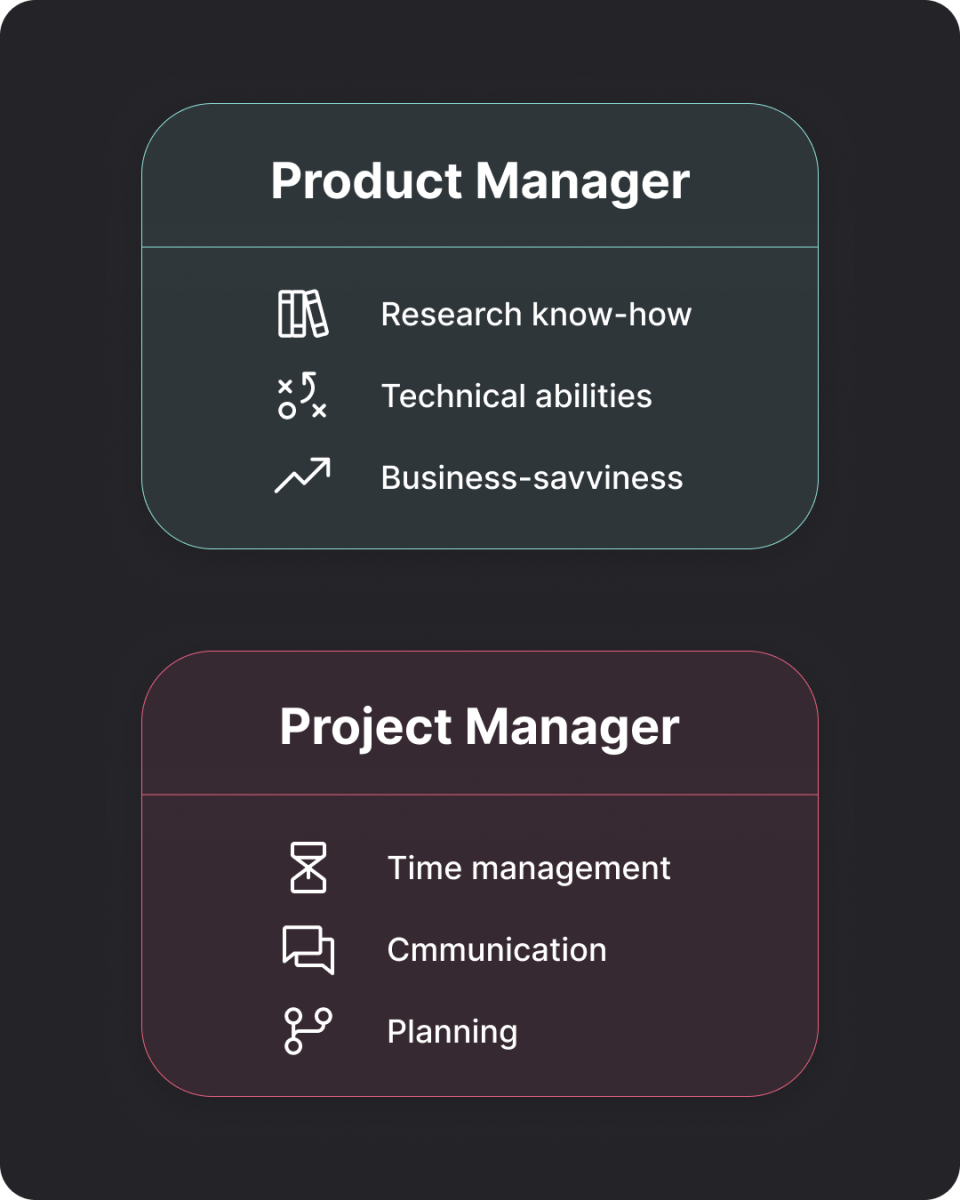
Product managers:
- Research know-how: Market and customer research can be big undertakings – it’s important to be skilled in deriving insights from data.
- Technical abilities: The level of technical knowledge required depends on the type of product being developed. But for software and other tech products, you might need some knowledge of coding to lead a team of developers.
- Business-savviness: You’re responsible for the product’s profit and loss, so you need the business knowledge to pivot accordingly.
Project managers:
- Time management: You’re the one in charge of the project timeline. The inability to meet team deadlines is the downfall of many project managers.
- Communication: Good communication throughout projects is key to managing a team efficiently. You should be skilled in communicating updates, receiving feedback, and resolving team conflicts.
- Planning: All projects are broken down into tasks, which allow project teams to divide and conquer to accomplish everything that needs to be done. Proper planning skills are necessary to ensure high-quality task management occurs.
5. Project management is temporary, product management is ongoing
As we’ve already discussed, one of the biggest differences between project and product management is the timeline.
Projects are short – there’s no need for them to continue once the project objectives have been met. Whereas with product management, there’s no limit to how long a product will exist in the market, as it’s completely dependent on whether that product continues to meet customer needs.
Some products come and go with trends while others exist for decades. Take Coca-Cola as an example. The company has been selling the same drink for 130 years because it continues to deliver what customers want and has created new product lines to meet changing tastes.
6. Research is a larger part of the product manager's role
Both positions involve research, however, product development requires customer and market research to inform development decisions along the way, whereas, for project managers, research primarily occurs at the beginning of the project.
This is because all projects undergo the five phases of project management. During the initiating phase, project managers are tasked with building their understanding of the project scope, which more often than not requires background research.

7. The project manager’s main task is work coordination
Who will redistribute work if someone has to suddenly leave the project team? Who will work with stakeholders when they want to adjust the project scope late in the timeline? Who will oversee changes to the final deliverables? The answer: the project manager.
Unlike product managers, project managers must invest a considerable amount of time into ensuring their team is running smoothly and according to schedule, while also encouraging team accountability. The result of this is a lot of work coordination – deciding who will take on what tasks and keeping a handle on the project scope.
Also read: Project Administration: A Crucial Part of Project Management
8. Each role has differing end goals
As you might’ve guessed, the ultimate goal of the product manager is to deliver an exceptional product. Your scope is fairly limited in this way, as your objective is crystal clear and everything you work on leads back to delivering that high-quality product.
The goal of a project manager is to oversee a project’s completion while also keeping the budget, timeline, and quality under control. This means the scope of project managers is oftentimes wider since there are smaller goals at play that all contribute to the larger goal of successfully finishing the project.
Related: 7 Steps to Best Track Project Budgets & Maximize Profits
The primary goal of product managers never really changes. Project managers’ goals, on the other hand, are subject to frequent changes according to their current project and their client’s wishes. It’s not uncommon for project managers to complete several projects for different products over the course of a year – all of which come with their own unique set of objectives.
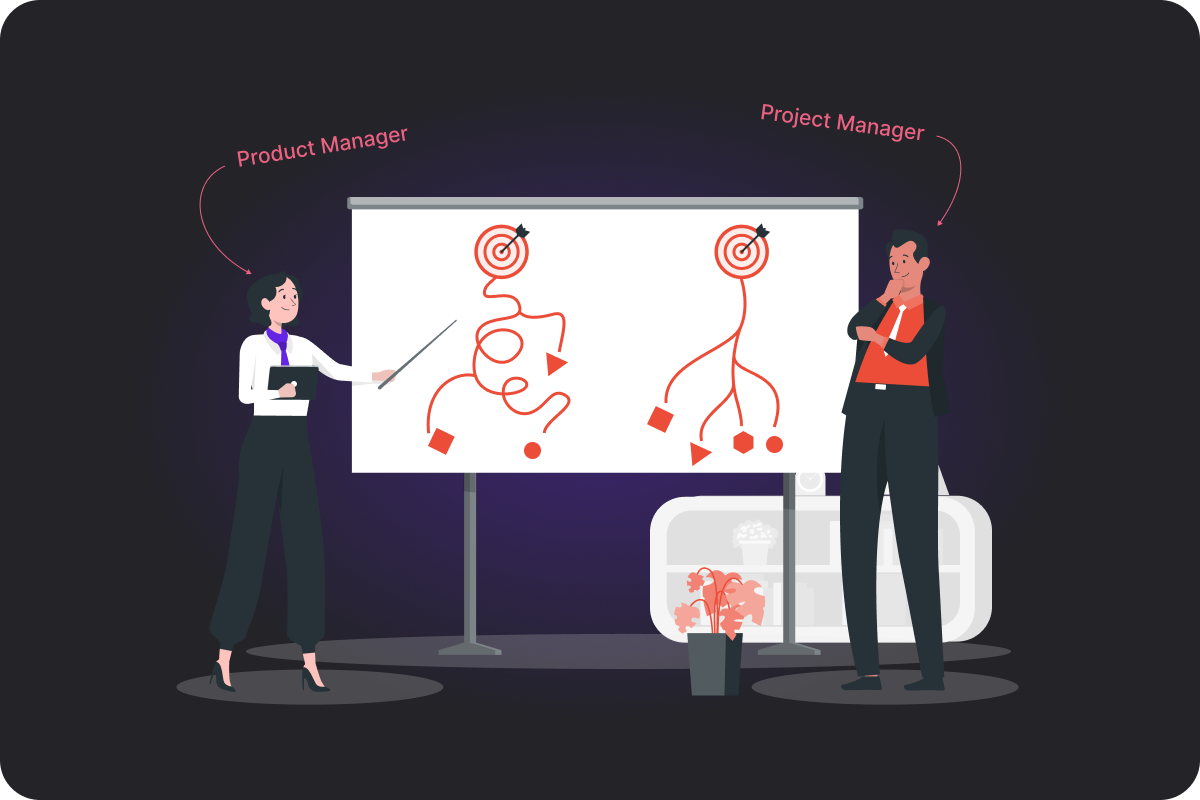
Can one person assume the roles of product manager and project manager simultaneously?
While both positions certainly require similar leadership and problem-solving abilities, they also require different skill sets due to the unique nature of each role. External- and internal-facing activities are very different, and trying to juggle both is often too much for a single person to manage.
Not to mention, having the same person manage both the project and product side of things can sometimes create bottlenecks when too many items require the attention of one person at the same time.
That said, having one person do both can work in very small companies with the help of project management software and techniques like time blocking and time tracking. For complex projects though, you’ll want to separate the positions.
Manage your projects with Rodeo Drive
Product manager vs. project manager: Which one is right for your team?
Whether your team needs a product or project manager entirely depends on your goals and current challenges, so you’ll want to first consider what your team needs help with.
If your team lacks a strong product development vision, you’ll want to hire a product manager who can conduct research on customer needs and determine development plans.
But if your organization has a solid strategy and you’re having trouble executing it, then you should look into adding a project manager to your team. Project managers ensure the team is progressing according to schedule, communicating effectively, and that objectives are being met.
Your organization may be struggling with both strategy and execution. Should this be the case, you should consider hiring both a project manager and a product manager.
Takeaway
Well, there you have it – we hope we’ve left you with a clear understanding of the differences between a product manager and a project manager.
At the end of the day, the positions are two sides of the same coin. For example, product development can require the assistance of several projects in order to prepare for a successful launch. The product manager and project manager are working together to deliver value for the customer, just in different ways.
When in doubt, recall that product managers deal with the what and why and project managers the how and when. Product managers create the project strategy and project managers execute it using projects.
Read next:
What Does Project Management For Creatives Look Like?
12 Ways to Improve Team Accountability [Remote & Onsite]
The Ultimate Guide for Creative Project Management in 2022





